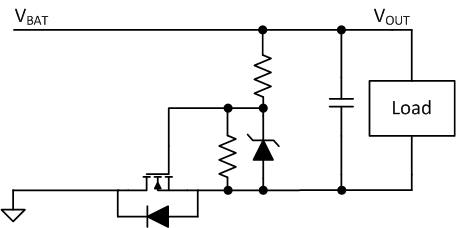SLVAE57B February 2021 – October 2021 LM5050-1 , LM5050-2 , LM5051 , LM66100 , LM74202-Q1 , LM74500-Q1 , LM74610-Q1 , LM74700-Q1 , LM74720-Q1 , LM74721-Q1 , LM74722-Q1 , LM7480-Q1 , LM7481-Q1 , LM76202-Q1 , SM74611 , TPS2410 , TPS2411 , TPS2412 , TPS2413 , TPS2419
- Trademarks
- 1 Introduction
- 2 Reverse Battery Protection
- 3 ORing Power Supplies
- 4 Reverse Battery Protection using MOSFETs
- 5 Reverse Polarity Protection vs Reverse Current Blocking
- 6 What is an Ideal Diode Controller?
- 7 Automotive Transient protection with Ideal Diode Controllers
- 8 ORing Power Supplies with Ideal Diode Controllers
- 9 Integrated Ideal Diode Solution
- 10Summary
- 11References
- 12Revision History
4.4 Reverse Battery Protection using N-Channel MOSFET
An alternate method of reverse battery protection is using an N-Channel MOSFET on the low side, such as the ground return path. The operating principle is similar to the P-Channel MOSFET in Figure 4-1. During normal operation, the body diode of the MOSFET is forward biased and conducts until the MOSFET is turned ON. MOSFET is turned ON quickly as the battery input charges the gate through the current limiting resistors. MOSFET turns OFF during static reverse battery or dynamic reverse battery conditions after the battery input starts to swing negative, as the gate-source voltage starts to go below MOSFET Vth and swings negative.
 Figure 4-8 Reverse Battery Protection Using N-Channel MOSFET
Figure 4-8 Reverse Battery Protection Using N-Channel MOSFETSection 4.1 describes the performance during the dynamic reverse polarity is similar to the P-Channel MOSFET solution. However, a jump in the system ground voltage during turn ON/OFF or load current transients may not be tolerated by all systems and needs to be considered during system designs.